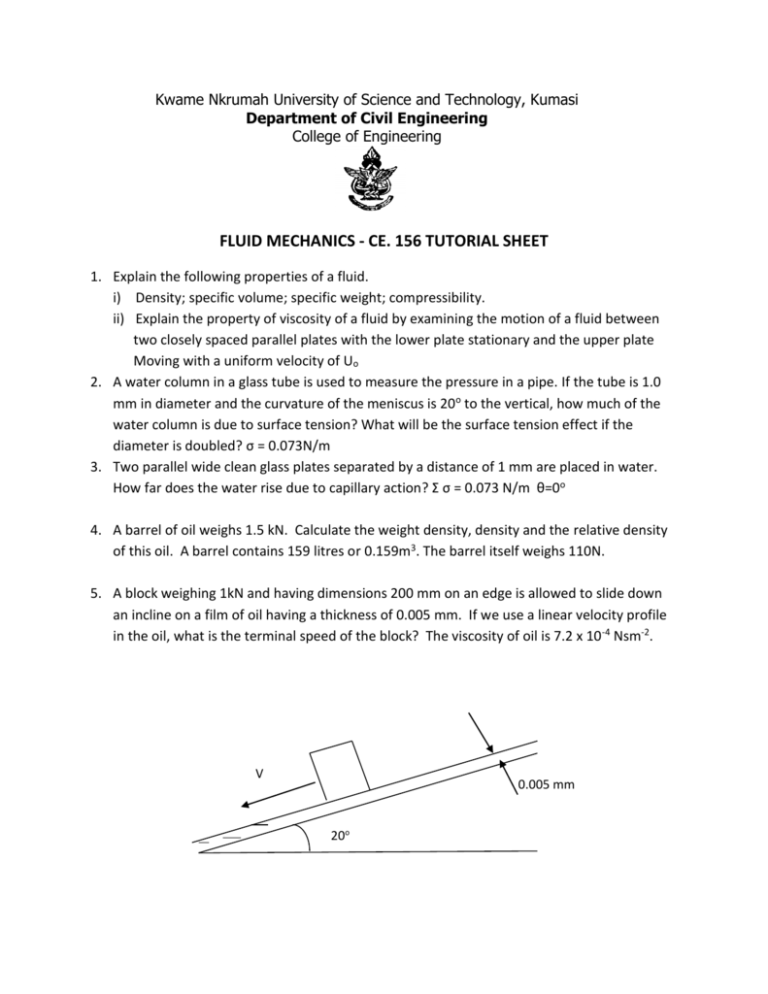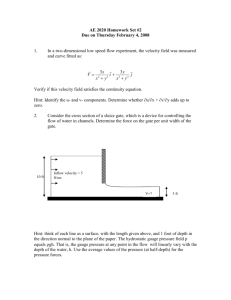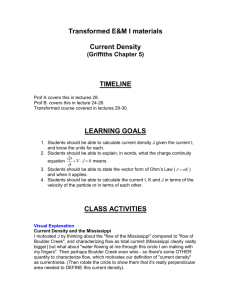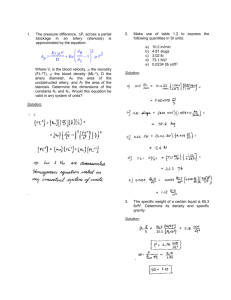FLUID MECHANICS CE 156 Tutorial Sheet
advertisement

Kwame Nkrumah University of Science and Technology, Kumasi Department of Civil Engineering College of Engineering FLUID MECHANICS - CE. 156 TUTORIAL SHEET 1. Explain the following properties of a fluid. i) Density; specific volume; specific weight; compressibility. ii) Explain the property of viscosity of a fluid by examining the motion of a fluid between two closely spaced parallel plates with the lower plate stationary and the upper plate Moving with a uniform velocity of Uo 2. A water column in a glass tube is used to measure the pressure in a pipe. If the tube is 1.0 mm in diameter and the curvature of the meniscus is 20o to the vertical, how much of the water column is due to surface tension? What will be the surface tension effect if the diameter is doubled? σ = 0.073N/m 3. Two parallel wide clean glass plates separated by a distance of 1 mm are placed in water. How far does the water rise due to capillary action? Σ σ = 0.073 N/m θ=0o 4. A barrel of oil weighs 1.5 kN. Calculate the weight density, density and the relative density of this oil. A barrel contains 159 litres or 0.159m3. The barrel itself weighs 110N. 5. A block weighing 1kN and having dimensions 200 mm on an edge is allowed to slide down an incline on a film of oil having a thickness of 0.005 mm. If we use a linear velocity profile in the oil, what is the terminal speed of the block? The viscosity of oil is 7.2 x 10 -4 Nsm-2. V 0.005 mm 20o 6. In the diagram, the weight falls at a constant velocity of 46 mm/s. calculate the approximate viscosity of the oil. 149.5 mm G=9N 150 mm 7. A cylinder 300 mm in diameter and 2 m long is concentric with a pipe of 308 mm in diameter. What force is required to move the cylinder along the pipe at a constant velocity of 2 m/s if the space between the cylinder and the pipe is filled with oil of kinematic viscosity 6.0 x 10-4 m2s-1 and relative density of 0.92 8. A 15 cm diameter journal runs in a bearing 30 cm long. The lubricant used has a density of 855 kg/m3 and a kinematic viscosity of 1.8 x 10-4m2s-1. If the radial clearance may be assumed to be uniform and equal to 0.05 mm, determine the power required to overcome the viscous resistance of the lubricant when the journal rotates at 300 rev. per min. 9. The power dissipation due to friction in a cylindrical bearing of a pump motor rotating at 1500rev. per min has been estimated as 6 watts. If the bearing is 7.61 cm long and 3.8 cm in diameter, calculate the clearance between the shaft and its journal. The oil viscosity is 4.8 x 10-3N s m-2.. 10. A vertical shaft of length l rotates in a bearing. It is assumed that the shaft is concentric with the bearing journal. A film of oil of thickness e and viscosity μ separates the shaft and from the bearing journal. If the shaft rotates at a speed of ω radians per second and has a diameter of D, what is the frictional torque to be overcome at this speed? What is the power dissipated? 11. Air is introduced through a nozzle into a tank of water to form a stream of bubbles. If the bubbles are intended to have a diameter of 2 mm, calculate by how much the pressure of air at the nozzle must exceed that of the surrounding water. Assume σ= 0.0727 12. a) With atmospheric pressure at 100xg N/m-2, what absolute pressure corresponds to a gauge pressure of 138xg NM-2? b) When the barometer reads 762 mm Hg, what absolute pressure corresponds to a vacuum of 305 mm Hg. c) Barometric pressure is 758 mm Hg. Calculate h 241 mm Hg vacuum po h 13. From first principles using Newton’s second law of motion, derive Euler’s differential equation of hydrostatics. Hence show that if gravity is the only body force acting on the fluid then (dp)/(dz) = -γ and hence p =po+ γh Where p is the pressure at a depth h in the fluid; po is the external pressure at the surface of fluid 14. Compute the atmospheric pressure at an elevation of 6,000 m considering the atmosphere as a static fluid under the following conditions: i) Air at constant density ii) Constant temperature between sea level and 6,000 m iii) Isentropic conditions iv) Air temperature decreasing linearly with elevation ay a standard lapse rate of 0.006507 oC/m Standard atmosphere at sea level: po = 760 mmHg 0r 101.3 kPa; To = 15oC; γo = 11.99Nm-3; ρ = 1.2232kgm-3; μo = 1.777 x 10-8kNsm-2. 15. In a light aircraft, the cabin pressure is to be maintained at 80% that of atmospheric pressure on the ground. The ground is 3000 m above sea level. If for structural reasons, the outside to inside ambient pressure ratio is not to be smaller than 0.6, what is the maximum height hmax above sea level that the aircraft may fly in a standard atmosphere. Standard atmosphere at sea level: po = 760 mmHg 0r 101.3 kPa; To = 15oC; γo = 11.99Nm-3; ρ = 1.2232kgm-3; μo = 1.777 x 10-8kNsm-2. 16. An inclined tube manometer consists of a vertical cylinder of 35 mm diameter to the bottom of which is connected a tube of 5 mm diameter inclined upwards at 15 o to the horizontal. The manometer contains oil of relative density 0.785. The open end of the inclined tube is connected to an air duct while the top of the cylinder is opened to the atmosphere. Determine the pressure in the air duct if the manometer fluid moves 50 mm along the inclined tube. What is the error if the movement of fluid in the cylinder is ignored? Comment on the results. 17. A manometer consists of a U tube of diameter d the upper part of each limb being enlarged to diameter D. The small tube contains liquid of relative density Sm and on top of this in each limb is a liquid of relative density S. The free surfaces are in the enlarged parts and the surfaces of separation between the two liquids of relative density Sm and S are in the small tube and initially level. Prove that the pressure difference, ΔP in a gas which when applied across the manometer produce a difference in the interface levels of h in the small tube, the free surfaces remaining in the enlarged ends is given by DRAWING d 2 S p S w gh 1 m S D 18. The drawing shows a manometer for measuring pressure of fluids. Z0 is the height of the mercury when both mercury column are the same height. R is the reading of the column C above the zero point when the fluid in A is under some pressure but not the same as Y. Let γ’ be the specific weight of the mercury while γ is the specific weigh of the fluid I A and connecting tubings. Prove that 2 d1 ' ' p A z o R d 2 DRAWING 19. The inverted U-tube is used to measure the pressure difference between two points A and B in an inclined pipeline through which water flows. The difference of level h = 0.4 m; X = 0.2 and y = 0.3 m. Calculate the pressure difference between points B and A if the top of the manometer is filled with: i) ii) Air Paraffin of relative density of 0.75 h Y B X C B y Zo R A A For problem 18 For problem 19 RELATIVE EQUILIBRIUM OF FLUIDS 20. An open tank 250 mm long, 100 mm wide and 200 mm high is filled with water to a height of 100 mm. The tank is then placed on a horizontal conveyer belt which is accelerating at a constant rate of 5 m/s2. Will the water spill from the tank? What will be the angle of inclination of the surface of the water during the movement? If the height of the tank was 150 mm, how much water would be left in the tank when it comes to a stop? 21. If the U-tube is rotated about the axis O-O at a rate of 16.06 radians per second, determine the new position of water surface in the outside leg during rotation. O 120 cm ω=160rad/s 150cm 30 cm O 22. A cylindrical tank with liquid of S.G. of 0.8 is 30 cm in diameter and 30 cm high. This tank is rigidly fixed to a rotating arm of radius 60 cm. The arm rotates so that the velocity at the point A is 2.8 m/s. If the pressure at A is 200 kPa, calculate the pressure at B. B 30cm 30cm A 60cm 23. A tank 6 m long with water of specific weight of 1000 N/m3 is being a,ccelerated at the rate of 4 m/s2. Find the angle of inclination of the water surface to the horizontal and calculate the levels of water at the back rear and the front rear relative to the initial levels. 24. A tank on a tanker-truck is filled completely with gasoline which has a specific weight of 6.60 kN/m3. a) If the tank on the trailer is 6.1 m long and if the pressure at the top rear end of the tank is atmospheric, what is the pressure at the top-front when the truck decelerates at the rate of 3.05 m/s2? b) If the tank is 1.83 m high, what is the maximum pressure in the tank? 25. If the U-tube is rotated about the axis O-O at the rate of 8 rad/sec., determine the new positions of water in the limbs O ω=8 rad/s 15.3 cm 30.5cm 15.3cm O 26. Two chemical processes A and B which under normal conditions would have taken several months are found to be feasible instantaneously under the conditions: i) Of weightlessness for the process A ii) That with a given mass, process B experiences twice its weight. These processes are to be carried out in a vertical lift. Calculate the accelerations to be given to the lift to satisfy the above 27. A tube ABCD has the end A opened to the atmosphere and the end D closed. The portion ABC is vertical while the portion CD is a quadrant of radius 250 mm with its centre at B, the whole being arranged to rotate about its vertical axis ABC. If the tube is filled with water to a height in the vertical limb of 300 mm above C, find the speed of rotation which will make the pressure head at D equal the pressure head at C. PLANE SURFACES IMMERSED IN FLUIDS 28. A rectangular plate 1 m wide by 2 m long is immersed in water of density 1000 kg/m3. The shorter side is parallel to the water surface and 0.5 m below it. The longer side is inclined at 60 o to the vertical. Calculate the magnitude, direction and location of the force acting on one side of the plate due to water pressure. 29. A bridge across a river has an elevation as shown. When the river is in flood, the upstream water surface is level with the road surface and the downstream level is 5 m below it. Assuming the pressure distribution to be hydrostatic, calculate a) the horizontal thrust upon the bridge and b) the overturning moment acting upon it. 0.92m Hinge 3 13m 25 m 3.1 m 3.1 x3.1 sq. gate 5m Stopper Fig. for Q 29 Fig. for Q 30 30. Determine the force due to hydrostatic pressure, acting on the hinge of the gate. 31. The rectangular gate AB is 3.05 m x 1.22 m in dimension and its pin connected at the point B. If the surface on which the gate rests at A is frictionless, what is the reaction at A? 32. A vertical gate 20m x 5m is hinged in a stream as shown in the diagram above. The gate is held in its position by four cables at the top. Calculate: i) The resultant hydrostatic force on the gate ii) The tension in each cable iii)The horizontal reaction of the hinge 2m cable B 3.05 x 1.22 gate 30o H1=20 m A hinge 33. A 1m diameter flood gate placed vertically is 4m below the water level at its highest point. The gate is hinged at the top. Compute the resultant hydrostatic force on the gate and the point of action of this force. Compute also the horizontal force to be applied at the bottom of the gate in order to open it. The water level at the downstream of the gate is 0.5m. 34. Determine the minimum volume of concrete (γ 23.6kN/m3) needed to keep the 0.305m wide gate in a closed position. The gate is hinged at the bottom. 0.305 1.22m Concrete block hinge 35. The angle between a pair of lock gates is 1400 and each gate is 6m high and 1.8m wide, supported on hinges 0.6m from the top and bottom of the gate. If the depth of water on the upstream and downstream sides is 5m and 1.5m respectively, estimate the reactions at the top and bottom hinges. 36. A rectangular dam is 6.1 m high and the depth of water upstream and downstream are 4.6m and 0m respectively. Calculate the width of the dam that is necessary to prevent the dam from sliding. The 3m specific weight of the concrete is 2.4 kN/m3 and the coefficient of friction between the base of the dam and the foundation is 0.42. Use 1.5 as the factor of safety (F.S) against sliding. Will it also be safe against overturning? 37. A masonry dam of trapezoidal section is 10 m high. It has a top width of 1.5m and a bottom width of 6.5m. The water face of the dam has a batter of 1:10. If the water level is at the top of the dam, find the maximum and the minimum normal stresses at the base. S.G of masonry is 2.3. 38. A tank 1.22m wide contains water to a depth of 1.83m and oil of S.G.= 0.8 for a further 3.05m. Find the resultant force on one side of the tank and the point of action of this force. 39. The circular gate ABC has a 1m radius and is hinged at B. Compute the force P just sufficient to keep the gate from opening when h is 10m. 40. For the conditions given in problem 39, derive the analytical expression for P as a function of h. A h 1m B 1m C Problem 39 41. The submerged sector gate AB is one-sixth of a circle of radius 6m. The length of the gate is 10m. Determine the amount and location of the horizontal and vertical components of the total resultant force acting on the gate B A 60o Oil of S.G =0.80 O A Problem No. 41 Problem No. 42 B 42. The 1.83m diameter cylinder weighs 2273 kgf and 1.52m long. Determine the reactions at A and B, neglecting friction. 43. A 2.44m diameter cylinder weighs 227.3 kgf and rest on the bottom of a tank that is 0.91m long. Water and oil poured into the left and right hand portions of the tank depths of 0.61m and 1.22m respectively. Find the magnitude of the horizontal and vertical components of the force that will keep the cylinder touching the tank at B. 44. The profile of a mass concrete dam is parabolic. If the dam retains water to a depth of 60m, find the resultant thrust per meter run of the dam, its inclination to the horizontal and the point where it cuts the horizontal base line. 32m Oil of S.G = 0.75 Water 60m Problem No. 43 Problem No. 44 45. A sluice gate consists of a quadrant of a circle of radius 1.5m pivoted at its centre O. Its centre of gravity is at G. When the water is level with the pivot O, calculate the magnitude and direction of the resultant force on the gate due to the water and the turning moment required to open the gate. The gate has a width of 3m and a mass of 6000 kg. 46. A cylindrical control weir has a diameter of 3m and a length of 6m. Give the magnitude and direction of the resultant force acting on the weir from the fluid. O G 0.6 1.5m 3.0m 0.6 Problem 45 Problem 46 1.5m 47. The end of a reservoir is shaped as shown. Find the resultant thrust per metre run of the wall, its inclination to the vertical and the distance from A that it cuts the horizontal through A. C 3m B 3√3 m A Problem No. 47 48. In each of the cases presented below, find the force per unit length on the side AB of the cylindrical surfaces. 49. A piece of irregularly shaped metal weighs 300N in air. When the metal is completely submerged in water, it weighs 232.5N. find the volume and specific gravity of the metal. 50. Determine the magnitude and direction of the force necessary to hold a concrete cube 0.300m on each side, in equilibrium and completely submerged in a) mercury, Hg (s.g = 13.6) and b) water. s.g of concrete is 2.4 51. A cube of wood (s.g. = 0.6) has 0.2 m sides. Compute the magnitude and direction of the force F required to hold the wood completely submerged in water. 52. A hollow cube 1.0m on each side weighs 2,4kN. The cube is tired to a solid concrete block weighing 10.0kN. Will those two objects tied together float or sink in water? The s.g. of concrete =2.4 53. A hydrometer weighs 0.00485 lbs and has a stem at the upper end which is cylindrical and 0.11ins in diameter. How much deeper will it float in oil of s.g =0.780 than in alcohol of s.g = 0.821. 54. A hydrometer has a stem of constant cross-section which protrudes through the free surface. It is calibrated by marking the position of the free surface when floating in distilled water (s.g.=1.0)and by determining its submerged volume Vo when floated in another liquid, the stem may sit lower or higher at the free surface from this position by distance Δh. Show that h the liquid. Vo ( S 1) As (S ) where Asis the cross-sectional area of stem, S – specific gravity of 55. For a hydrometer, derive a formula for the float position h as a function of the specific gravity, the weight of the hydrometer, the diameter of the stem, and the specific weight of pure water. h is the height above the free liquid surface. Are the scale readings linear or non-linear? 56. A ship, with vertical sides near the water line weighs 4000tons with a draft of 22ft in salt water (γ=64.0 lb/ft3). Discharge of 200 tons of water ballast decreases the draft to 21ft. What would be the draft in fresh water? 57. A block of wood of rectangular section 4 ft wide and 6 ft deep is 12ft long and floats horizontally in sea water. If the weight density of the wood is 40 kb/ft3 find the volume of liquid displaced and the position of the centre of buoyancy. 58. A wooden cylinder of circular section and uniform density (s.g.= 0.6) is required to float in oil of s.g = 0.8. If the diameter of the cylinder is d and its length is l, show that l cannot exceed about 0.817d for the cylinder to float with its longitudinal axis vertical. 59. The floor of a water tight basement of 10m x 20m house is 2m below the groundwater level. Assuming the density of the concrete floor is i2.6 g/cm3, determine the required floor thickness to prevent uplift with a factor of safety of 1.5. 60. A barge is 42ft long, 25 ft wide, and 10ft high with a flat bottom and square ends. It has a draft of 6.0 ft when fully loaded and floating in an upright position. The centre of gravity of the barge when fully loaded is on the axis of symmetry and 1.0ft above the water surface. Is the barge stable? If it is stable, what is the righting moment when the angle of heel is 12o? 61. A solid wood cylinder has a diameter of 2.0ft and a height of 4.0ft. The specific gravity of the wood is 0.6. If the cylinder is placed vertically in oil of s.g = 0.85, would it be stable KINEMATICS OF FLUID MOTION 62. Given the velocity field; V(x,y,z,t) = (xy+t)i +(3z+10)j +20k m/s, what is the velocity vector at positions x = 10m, y = 1m and z =2m where t=5 s? What is the magnitude of the velocity? 63. The velocity components in a flow of a fluid are known to be ux=6xt +y2z+15 m/s; uy=3xy2+t2+y m/s; and uz=2+3ty m/s. What is the velocity vector at (3, 2, 4) m at time t = 3 s? What is the magnitude of this vector at this point and time? 63. Given the velocity field V = (6x)i+ (16y+10)j +(20t2)k m/s, what is the pathline of a particle which is at (2, 4, 6) at time t = 2s? 64. Given the Eulerian velocity vector field V(x, y, z, t) = 3t +xz +t+ty2k, find the acceleration of a particle. 65. A velocity field is given by U = 3y2, V= 2x, W=0. Is the flow steady or unsteady? Is the flow two dimensional or three dimensional? At (x,y,z) = (2,1,0) compute the a) velocity; b) local acceleration; c) convective acceleration 66. Which of the following velocity field satisfies conservation of mass for incompressible flow? A) u=x; v=y ; b) u=y, v=x; c) u=2x, v=-2y; d) u=3xt, v= 3yt; e) u= xy +y2t, v= xy +x2t; f) u= 3x2y2, v=2xy3 67. Given the velocity field V=10x2y +20(yz+x) +13k, what is the total angular velocity of a fluid particle at (1,4,3)m? 68. Is the following flow field irrotational or not? V = 6x2yi + 2x3j + 10k 69. An incompressible steady flow pattern is given by u=x3+2z2 and w=y3-2yz. What is the most general form of the third component; v(x, y,z) that satisfies continuity 70. The velocity components of a possible incompressive flow are u= 2Cxy and v=C(a2+x2-y2) where a and c are constants. I) do the above components satisfy the continuity equation? Ii) Is the flow rotational or irritational? Iii) Find the stream function; iv) find the velocity potential







